I feel like I owe it to my friends and family to finally write about what I’ve been up to the past couple of years. A quick burst of photos shared as I traveled across a few new countries, had many people questioning what on earth I was doing again on the other side of the world. But this time around it was different. A more intentional approach. Over the past couple of years, my freelance design business began gaining traction and I knew if I wanted to maintain this lifestyle yet continue to explore other countries my style of travel would need to evolve as well. This time around, rather than a whirlwind trip between jobs, I would instead be taking my work with me on the road. Embracing the art of slow travel and seeing places more in-depth by living in each country one month at a time. This was a way to prove to myself that location didn’t matter, that I could thrive from anywhere, and my business could flourish all while on the road. So I’ll start where it all began last spring, in Lisbon, Portugal.


Why Lisbon?
Lisbon, or rather, Lisboa (Lish-boa), as the Portuguese pronounce it, had been an idea fluttering in the back of my mind ever since I had started working remotely. I had read that Lisbon was the perfect hub for anyone looking to transition into the international remote working lifestyle, as it hosted a major ‘digital expat’ community. I contemplated heading over and finding my own way, but throughout my research, I came across a program that had already paved the way. Queue, Remote Year.
What is Remote Year?
Remote Year (RY) is an organized experience program that brings together a curated group of professionals to live, work, and travel together in different international cities around the world without having to quit their jobs.
“Keep your job. See the world. Leave the planning to us.”
While they are not a job provider, the allure of Remote Year for me was that they take the guesswork out of finding accommodation and a workspace in each location. RY initially started out with only 12-month programs, but recently inducted a 4-month program to accommodate those wanting to try out the lifestyle, without the year-long commitment. After a bit of self-contemplation and a few phone calls loaded with questions for the onboarding staff, I decided this was the right next move. The group I joined was the pilot group of the 4-month programs to depart. We were called ‘RY Excelsior’ and were a part of the ‘Europe & Africa Program’. 35 strangers setting off on a social experiment of sorts, living in Portugal, Croatia, Czech Republic, and South Africa, each for one month at a time.
Arrival Day
On arrival day, myself and the other remotes were greeted at the airport by the RY Program Lead (PL) and handed our apartment keys and key card to the workspace. Each program that departs has a PL which acts similar to a project manager —or a mother hen at times — as they travel with the group all four months making sure everyone arrives safely and that everything runs smoothly. We hopped into a shuttle with whom would be our new roommate for the month along with a member of the City Team. City Team members were people who lived in each of the towns we would be staying but worked on staff for RY. Their job was to act as our local guide and the main point of contact for all things going on in the city that month. They assisted our group with anything from a lightbulb replacement in your living room, intel on where to find the best local food, or directions to the best spot to catch the sunset. It was an awesome resource to have, landing in a new city, and only knowing a few Duolingo words of the language. Obrigado! (Thank you)
 Pictured above are some of the RY gals on one of our first walks about the city.
Pictured above are some of the RY gals on one of our first walks about the city.
 Pictured above is my new friend Tomaś. A fellow surfer and member of the city team.
Pictured above is my new friend Tomaś. A fellow surfer and member of the city team.
Accommodation
Our apartment was located in the ‘Santos’ neighborhood of Lisbon. A less touristy, and more local side of town. The area was up and coming with a few modern coffee shops, tasty mom-and-pop restaurants, a tiny market on the corner, and only a 15-minute (semi- hilly) walk across town to the workspace. I was super lucky with the roommate I was paired with and she and I hit it off pretty quick, both having grown up in California. We scored a two-bedroom apartment, both with queen size beds, and two full-size bathrooms. The one interesting thing was that our place, like many apartments in Lisbon, didn’t have a living room. Which would turn out to be just fine as we knew we would be out exploring most of the days and getting to know our new travel family.
For those interested in a little walking tour of the apartment you can click here

 View from the apartment window.
View from the apartment window.








Workspace
Our workspace in Lisbon was called WIP Lisboa and was shared with other local entrepreneurs and freelancers. The space was in an old multi-story building with a remodeled modern interior providing various communal rooms to work from along with conference rooms and call booths available to book as needed.
The past few years have begun a major rise in location-independent work. Employers have not only been seeing the value in letting employees work remotely but with geographical location no longer a determining factor, it also allows employers to cast a wider net when recruiting talent. With the rise in offsite work, it has also created a new demand for coworking spaces to pop up in major cities all over the world. Companies like WeWork are one of the biggest names in the game with over 580 offices in 100 cities across the world. Chances are there is one, or two in a city near you.
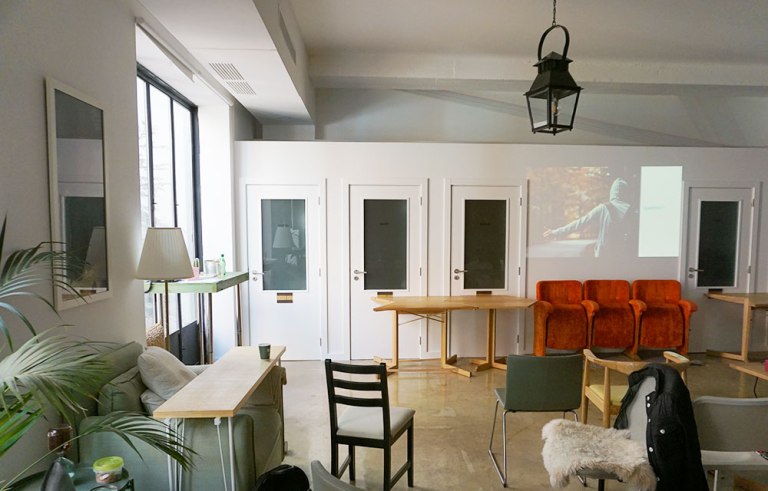


Freedom, Flexibility, Community
While remote work is an adjustment, the freedom and flexibility it brings being able to design your day is worth its weight in gold. Of my group, I’d say only 20% at the time were freelancers. The other 80% had asked their employers if they could continue their full-time role but work remotely for the 4-months we would be away. While both were great options, shoot anything that allows you to work from the road is a great option, the only obstacle was that with the full-time roles they still had to work the same time zone hours they would back home. Now for the people that were from Europe this was as easy as logging on 9-5. But for the west coast U.S. people this meant you were working nights. Because Lisbon was 8 hours ahead of the PST and 9:00am Pacific was 5:00pm in Lisbon. For these nocturnal night owls this was worth it because it meant they had the whole day to explore and check out the city. But it also meant missing out on nearly all dinners and happy hours. But, hey its a give and take.
A major benefit of traveling with a group of remote workers is the sense of community that it provides and the unique relationships you develop along the way. Think of it like a new job, where you are with the people every day, but now multiply that by 10 because you are also living with those same people as well. It allows you to get real close, real fast, spending essentially every waking second around one another.
As you get to know one another you began to uncover the many reasons each person had for signing up for a work-travel program of this magnitude. Whether it was the start of a new freelance career, the end of a relationship, or a desire to step out of their routine and try something new. For some, it was their first time abroad, and for others, it was the first time away from partners and loved ones for months at a time. But what was a unifying theme was that we all showed up with the same two underlying goals in mind: 1. Self-growth and 2. Stepping outside our comfort zones.
We were now a built-in family that would serve as a support system for one another throughout our time on the road, as we adjusted to new cultures, currencies, and cuisines each month.
Our first weekend together in Portugal I celebrated my 28th birthday with a handful of the RY gals. We had dinner and drinks at the hip arts district called the LX Factory and snagged some last-minute tickets to a ‘Milky Chance‘ concert. These girls stepped in right away to make me feel welcomed and loved and I knew they were about to become a big part of this adventure.



Lisboa: The City of Hills and Port Wine at Sunset
The first two things you notice about Lisbon are the colorful tiled walls and old architecture. The third you will quickly notice is that Lisbon is a city built on hills. Seven to be exact. It felt as if any direction we walked would lead us to an unusually steep street or dozens of stairs. But despite the flushed cheeks and loss of breath, the incline was always worth it as it often led us to a lookout above the city, or as they called them ‘mirodouros’.
These lookouts were where people gathered every single day at sunset to share some drinks, a chat, and watch the sun go down. It was such a fun and relaxing atmosphere as everyone gathered till the last drop of sunlight. It quickly became an evening after work ritual of ours as well.





People were constantly walking about town. It always felt so alive. And not in a stuffy, shoulder to shoulder crowded way, but just enough. No one ever felt like they were in a rush rather just going about their day. The liveliness of the city, tiles, and colors became my muses for the month as I stopped along any route I took to admire them.
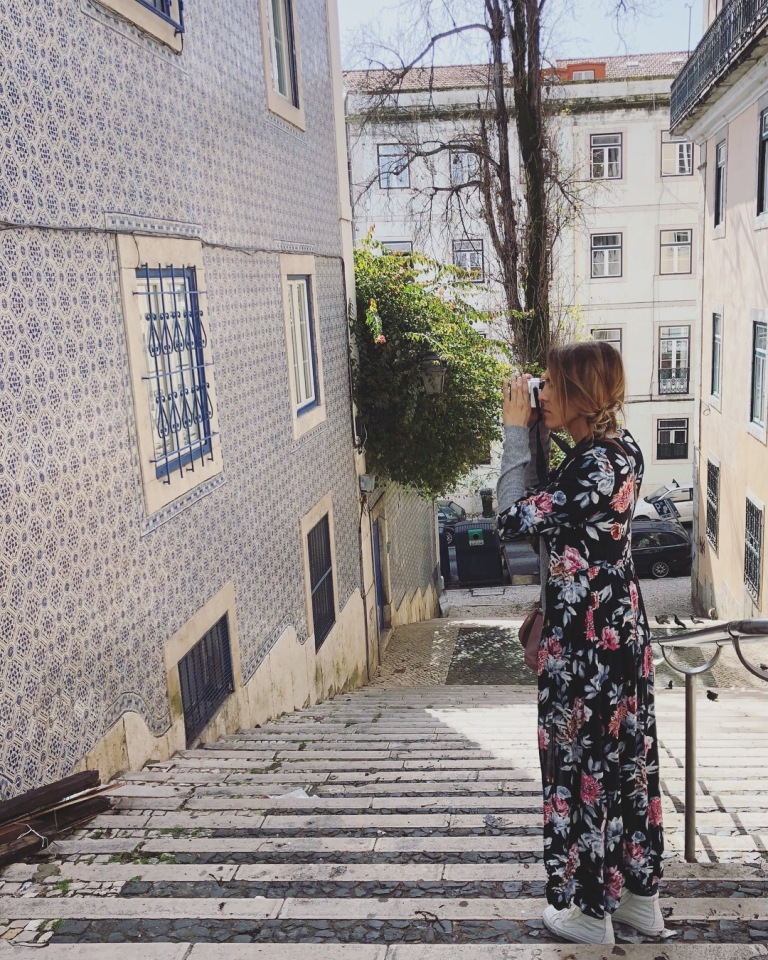











Tracks and Plus Events
Each month, we were provided with a few local experience ‘Tracks’ to choose from. These ranged from outdoor activities to ones about food, local art, and history. I chose a graffiti art walking tour, an azulejo tile painting class, and a day trip to Arrábida Natural Park just an hour outside of the city. In addition to the scheduled tracks, if you had extra time there were also ‘Plus Events’. These events were at an extra cost but were unique additional experiences. For example, one was a group Tomaś set up to go surf in the nearby beach town of Cascais, which I was particularly excited for having already packed my wetsuit along in my suitcase. What I didn’t realize was how cold these Atlantic waters were in the spring and that a 3mm wetsuit was a little too thin for these temperatures. Another outing we did together that first week was checking out a local ‘Sporting CP’ fútbol game. Because when in Europe, I think its almost mandatory to attend at least one game and support the local team.



 Pictured above is the tile I painted. If you look closely you can see the hidden fish.
Pictured above is the tile I painted. If you look closely you can see the hidden fish.
Azulejos
The Azulejo tiles play a major role in Portuguese architecture. The name Azulejos actually derives from an Arab word that means little polished stone. These painted glazed white terra cotta ceramics adorn the interior and exteriors of churches, palaces, and homes, and can also be found in kitchen areas. They were used to not only as insulation when it was cold, but also to keep the houses cool in the summer. Patterned tiles became a popular form of decoration. The most popular color you see in the Azulejos painted in is blue, followed by yellow and green. Intricate patterns can be found in the stone streets and promenades as well. No matter where you looked there was texture and color.
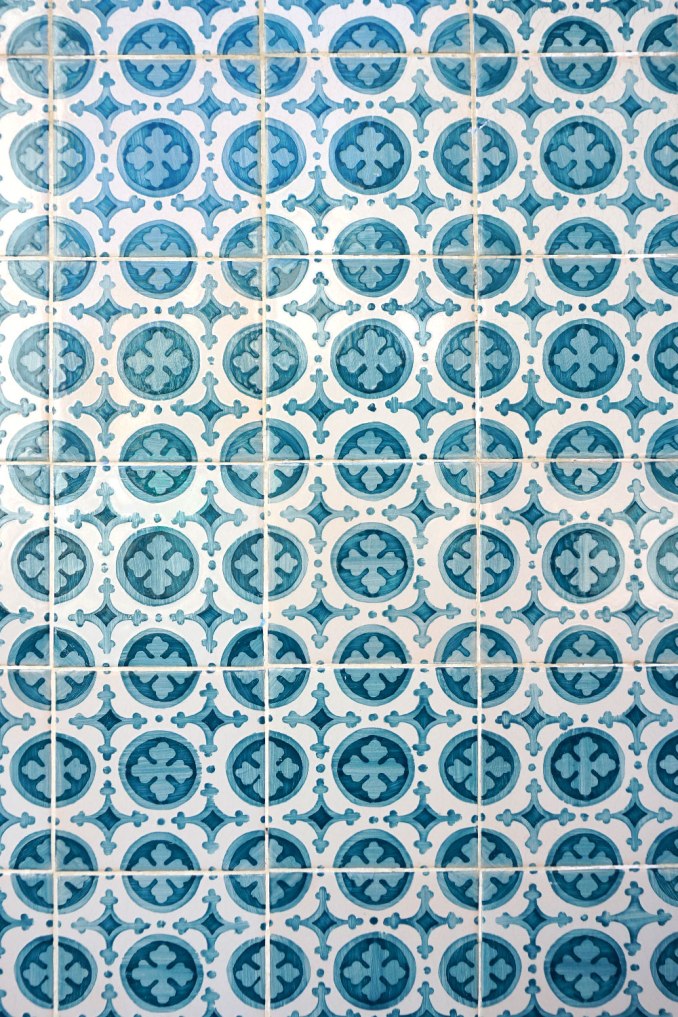



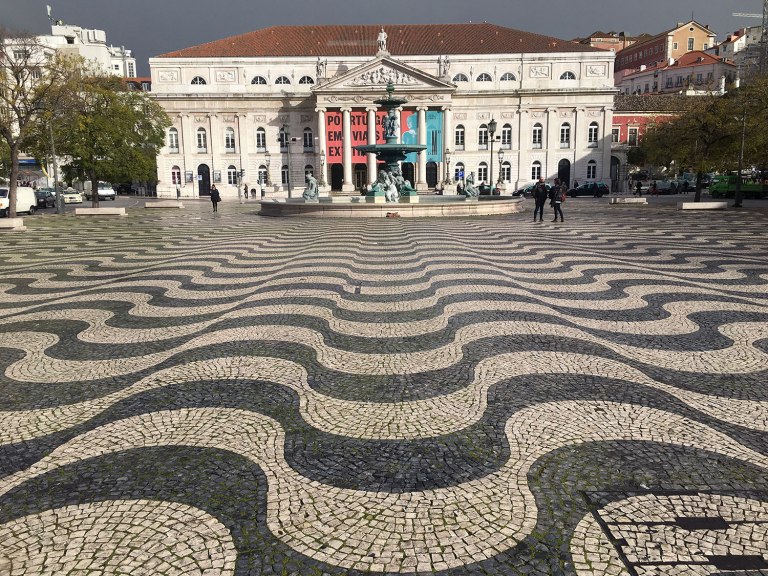
Street Art
Another thing that inevitably caught your eye was the vast street art that could be seen all over the city. From the walls to the cable cars, the street artists claimed the city as their canvas. Some of the main areas to find the most unique pieces is in the Alfama neighborhood and the walls of Barrio Alto. The artists’ styles varied from simple tags to bigger and more meaningful works bringing awareness to their countries struggles and peaceful revolution. Some artists played on the tile motif, while others filled the void of stolen tiles with poetry. Each street boasted another color, another viewpoint, and told another story. One of my favorites was an artist that would write “Pura Poesia” on the wall at places he felt were moments of ‘pure poetry’. It really began to resonate with me when I would find a view I enjoyed. As I stood, taking in the moment, I’d look to my left and notice those words, “Pura Poesia” written on the wall next to me. It was a calming and happy feeling knowing that at one point in time, someone had stood there in awe feeling the same way. A moment you could share across time, even when alone.




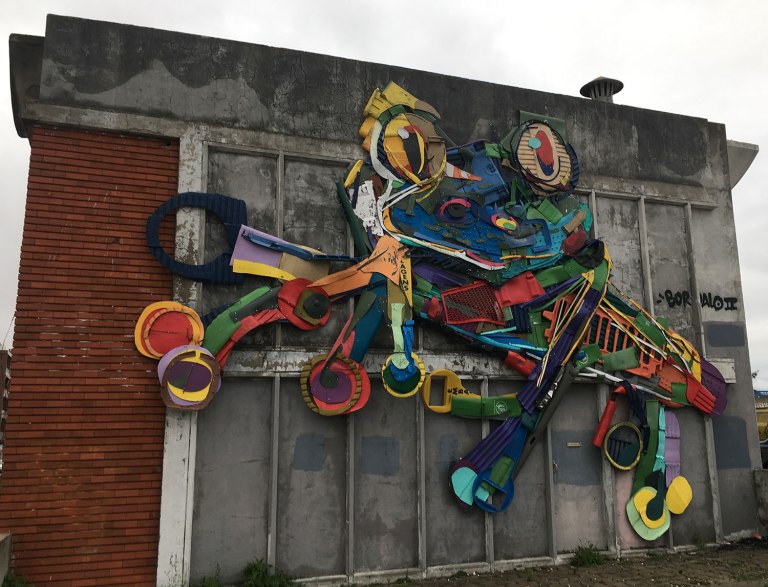


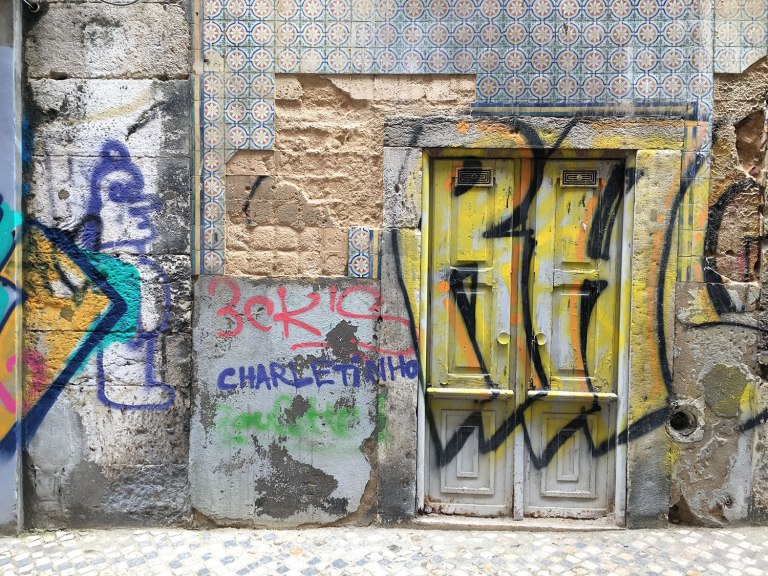


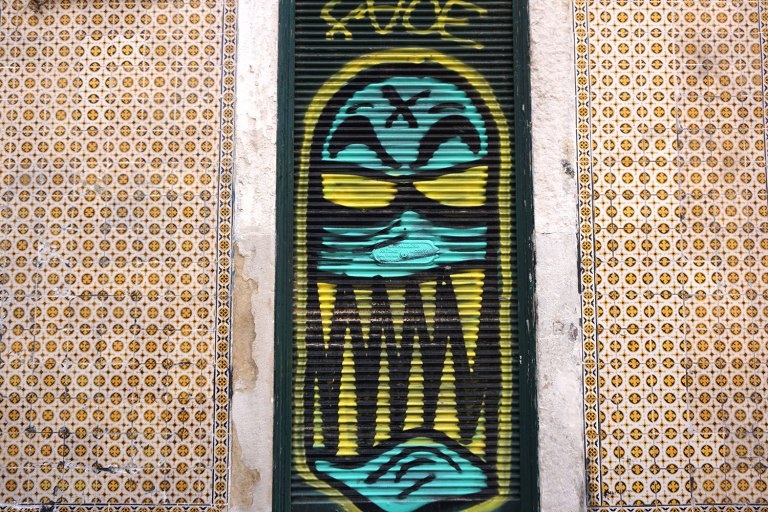



Portuguese Cuisine
Let’s get to the tasty stuff! My first taste of Lisbon gastronomy began with a Super Bock cerveja and some seafood tapas. Grilled Octopus and Inky Black Squid to be exact. And much to my surprise, I really enjoyed it. There were so many flavors of the sea I had yet to try. I knew it was going to be a deliciously tasty month.

The main Portuguese diet consists of seafood, potatoes, steak, chorizo sausage, black pork, coffee, and well, wine. Or at least my Portuguese diet did. There was good food everywhere you looked. Lisbon is home to a great mix of the old and new. There are traditional restaurants where you can enjoy local cuisine and listen to Fado singers while you dine. But there are also very hip and trendy new-age restaurants, each with their own seafood flare. The buildings are all very old, and some shops have been open for over 100 years. Because of this, every square foot of the city has character. One of my favorite things to do was to find one of the local restaurants and order steak on a stone. They bring it to the table while it’s still sizzling and you can continue to cook the meat to your liking. That plus a couple vases of house red wine. Now that was living. All for under $20.


Wine
Portugal is known for its many well-known wine regions throughout the country, the most famous being the Douro Valley. Because it is a small country that meant you always had amazing vinho tinto (red wine) close by, and for insanely cheap. I think we may have become accustomed to a healthy one bottle a day. The most famous wine of the Douro region was the sweet dessert wine called ‘Port’. There were actually 3 types of port wine: the most famous Tawny Port, the even sweeter Ruby Port, and the more dry tasting White Port. Each with their own unique flavor. I guess you have to just try them all, and I certainly did. And naturally, my favorite was the Tawny. A sip of that before bed with some dark chocolate was perfection. The second most popular wine was the vinho verde, the green wine specific to the Minho region, was a young refreshing wine that was best consumed cold.
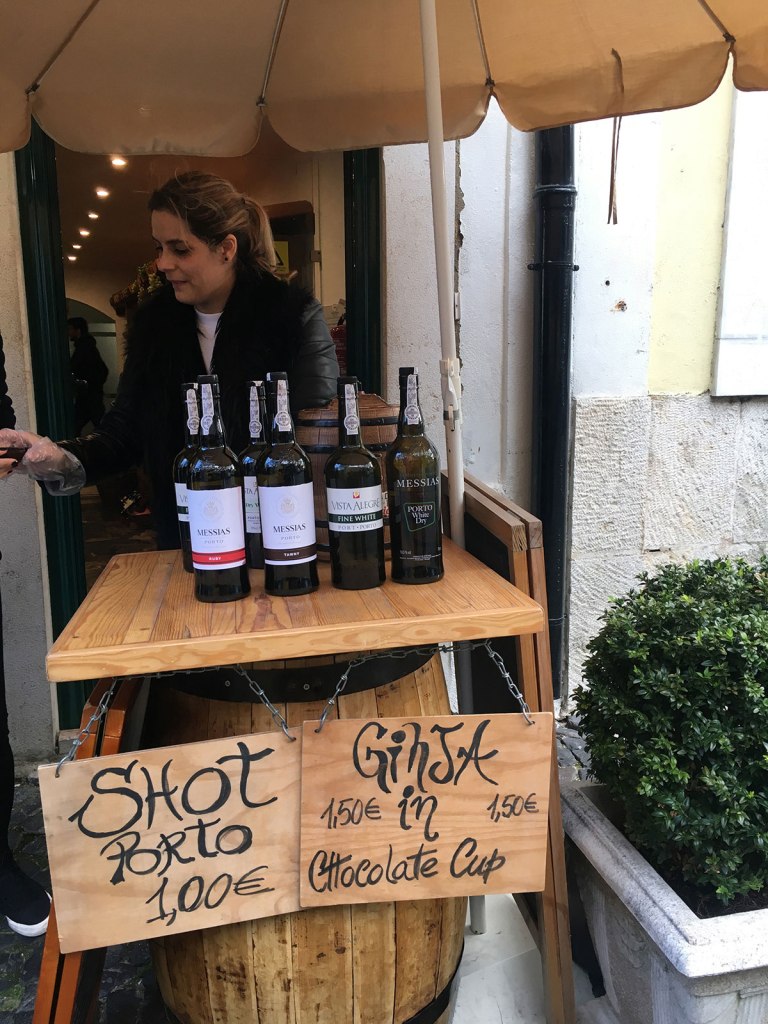
Cork
Portugal’s second-largest export, much to my surprise, was cork. Portugal’s countryside is home to the famous cork trees. Which you would begin to realize after doing a bit of shopping as almost any item at a souvenir shop around town had been made from it. Cork wallets, coin purses, shoes, backpacks, and even hats. Who knew!

Best Places to Eat Seafood and Drink Wine
Time Out Market – This former warehouse is known as “the best of the city under one roof” and hosts 24 restaurants and a handful of market vendors. Located in Cais Do Sodré neighborhood and right across from the metro station, it’s hall like dining with long tables creates a great atmosphere and endless choices for great food.
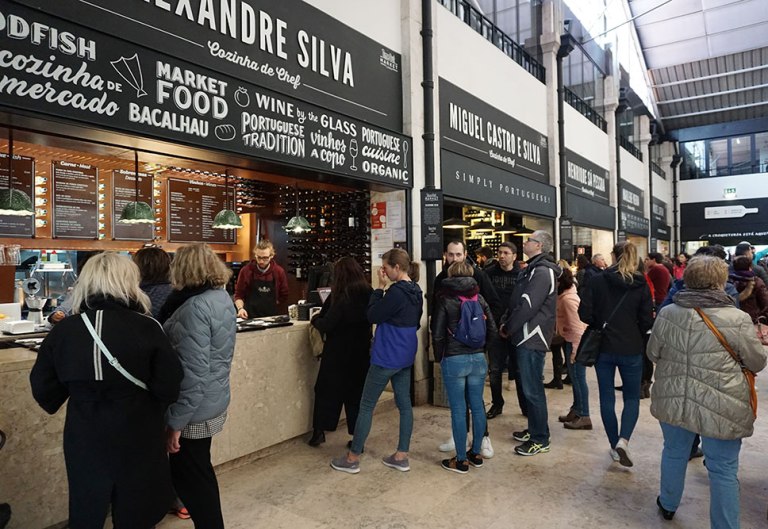
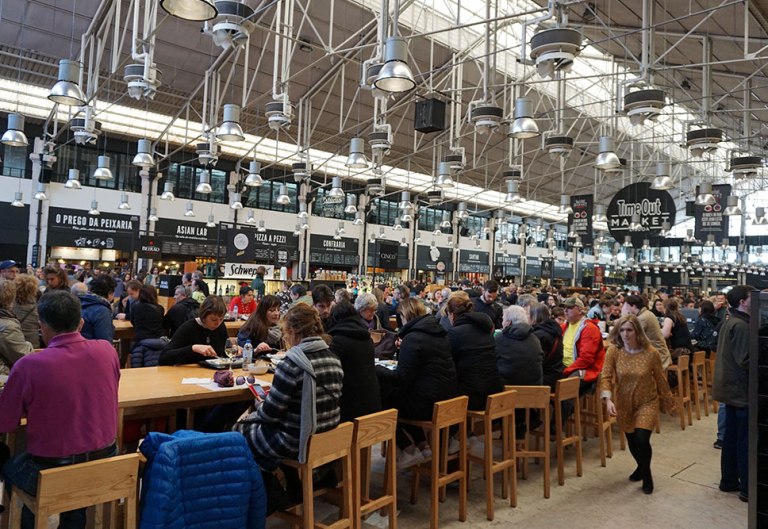
A Praça– Located in the hip LX Factory this restaurant was a great one to stumble into on my birthday. Great atmosphere and a variety of drinks and dishes. Be sure not to skip dessert. LX factory is also home tons of rad shops and galleries and tucked in the back corner lies an old factory warehouse has been converted into a concert venue. Be sure to check and see what’s on while you are there!
Pistola Y Corazon– A couple weeks in I was missing Mexican food and this place did not disappoint. With its funky and quirky illustrative decor and dimly lit shared table dining, this place always had a line out the door. Spicy taco plates and a variety of hot, hot, and hotter sauce options. *Tip get there early right when the dinner service starts to make sure you can get a table. If not, they serve margaritas in baggies to drink out front while you wait. Not too bad, ay?
A Cevicheria – Located in the upscale Principe Real neighborhood on the top of one of Lisbon’s hills this sought after ceviche spot is known for having some of best ceviche in town. Their menu has a variety of specialty ceviches with intense flavor but also has a sidewalk window where you can order seafood and drinks from a limited menu. A bit pricier but worth it.

Flor Da Laranja – If you are up for trying a new cuisine check out this insanely delicious Moroccan restaurant. Owned and operated by one woman, dinner is on a reservation basis only. This small relaxed restaurant is tucked in the maze of Barrio Alto and decorated with colorful African decor.
Barrio Do Avillez – Home of 4 restaurants in one. The Tavern, Páteo, Alley, and upstairs on the second floor open balcony overlooking the dining area below was Catina Peruana, which served an incredible, modern take on Peruvian cuisine. Pisco sours and loads of interesting tapas to share. I went to this place twice while I was in Lisbon because I couldn’t get it off my mind. From the ambiance and decor to the tapas. I would recommend 100%.
Fauna & Flora– The best-decorated cafe in Lisbon. And luckily was around the corner from my apartment. Loads of plants and flowers adorned the interior contrasted with colorful wooden tables. This modern cafe hotspot was the go-to for avocado toast enthusiasts, matcha lattes, and berry pancakes.
Copenhagen Coffee Lab – The best tasting coffee I found in town. With two locations in Lisbon, one in Principe Real and the other hidden in the winding streets of Alfama. This place brought a bit of Denmark to Lisbon with great coffee and danishes.
Other honorable mentions for coffee/brunch: Heim Cafe, Dear Breakfast, Hello Kristoff, Boavida.
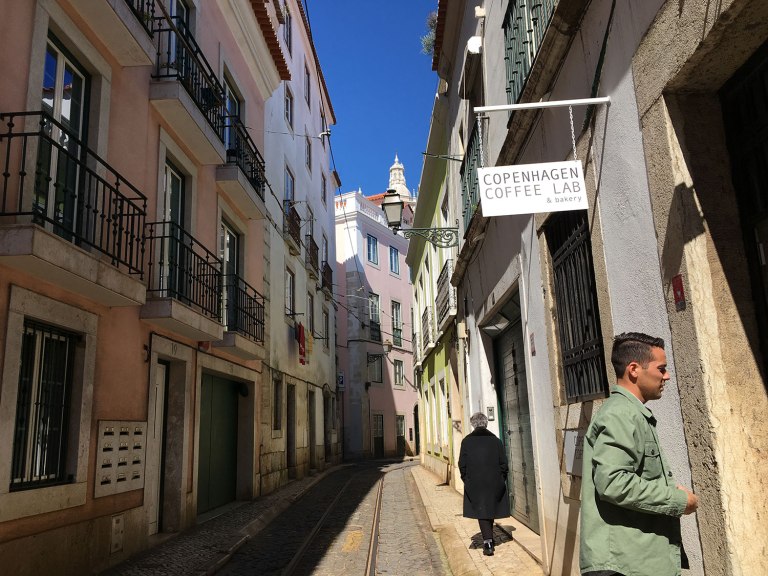
A Ginjinha – The oldest historic Ginja shop in Lisbon. This tiny open-faced shop serves only shots of Ginja, a Portuguese liquor made by infusing sour cherries with aguardiente and sugar. Since the shop is so small and can only fit two or three people standing shots are meant to be drunk out in front. A social sipping of sorts.

Park Bar – Hidden on top of a parking garage is an elevated garden terrace bar and the best place to watch the sunset. With an outstanding view of the 25 de Abril bridge and a hip atmosphere, it is a happy hour gem.. if you can find it.


Beer Festival
Throughout the month I was distracted by great wine but didn’t forget try to the beer! The craft beer scene much like back at home was booming out here as us beer lovers found our way to the Lisbon Beer Festival.

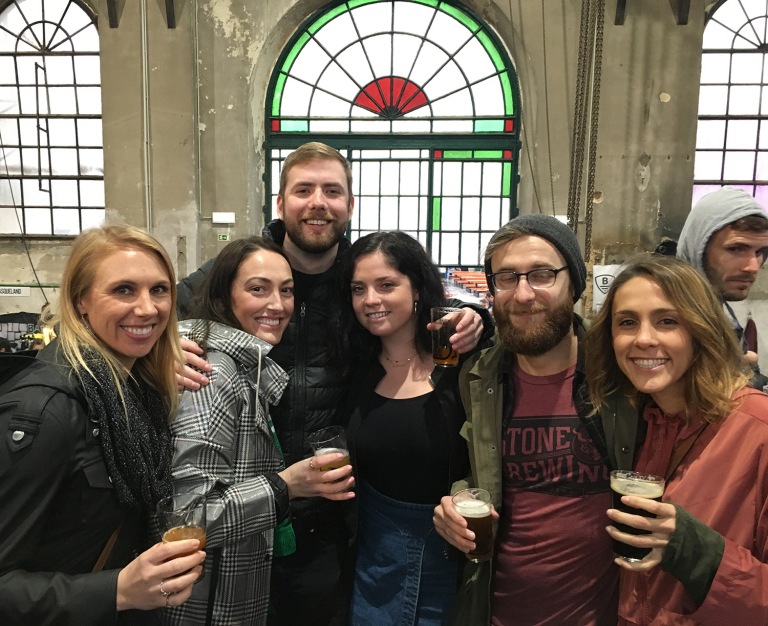
It was a great first couple of weeks kicking off our time in Lisbon. So much was going on that we barely had enough time to catch our breath. But even as in love as I was with the city I was eager to do a little road trip along the coast to see what else this beautiful country had to offer. And that’s what we set off to do next.
**Side Note: For anyone interested in joining Remote Year please feel free to reach out and send me an email at carlyclemcreative@gmail.com first so that I can refer you and you can get a discount on your first month.





Thanks for sharing such a detailed post! Keep up the great content.
LikeLike
Thanks for the great post. We were lucky to spend a few days in Lisbon and loved it, so it’s nice to see your photos and story as reminder.
LikeLike
My lovely hometown 🙂🙂 greetings! PedroL
LikeLike